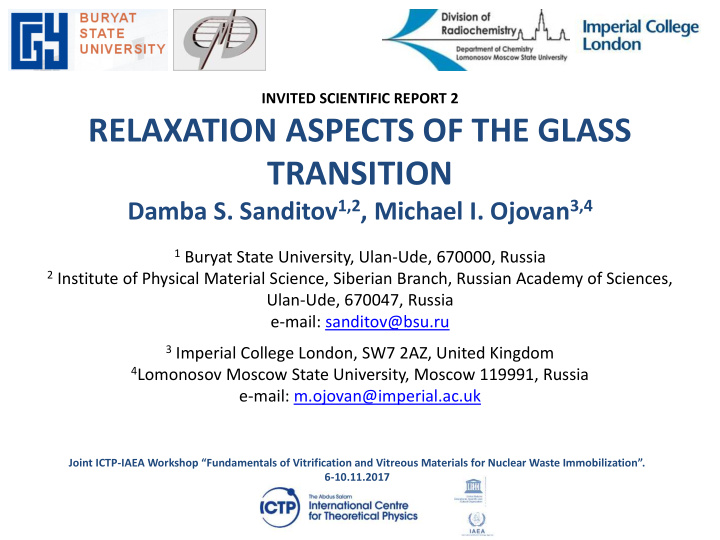



INVITED SCIENTIFIC REPORT 2 RELAXATION ASPECTS OF THE GLASS TRANSITION Damba S. Sanditov 1,2 , Michael I. Ojovan 3,4 1 Buryat State University, Ulan-Ude, 670000, Russia 2 Institute of Physical Material Science, Siberian Branch, Russian Academy of Sciences, Ulan-Ude, 670047, Russia e-mail: sanditov@bsu.ru 3 Imperial College London, SW7 2AZ, United Kingdom 4 Lomonosov Moscow State University, Moscow 119991, Russia e-mail: m.ojovan@imperial.ac.uk Joint ICTP- IAEA Workshop “Fundamentals of Vitrification and Vitreous Materials for Nuclear Waste Immobilization”. 6-10.11.2017
Contents • Background • Theories • Estimation of glass transition region δT g • Model of delocalised atoms • Sanditov equation of viscosity • Generalised Bartenev equation • Kinetic criterion of glass transition • Conclusions 2
Prof Sanditov Buryat State University named after Dorjee Banzarov
Lake Baikal is the largest freshwater lake by volume in the world, containing 22 – 23% of the world's fresh surface water. With 23,615.39 km 3 of fresh water, it contains more water than the North American Great Lakes combined. With a maximum depth of 1,642 m, Baikal is the world's deepest lake. It is considered among the world's clearest lakes and is considered the world's oldest lake — at 25 million years, making it the most ancient lake in geological history. 4
Republic of Buryatia, Ulan-Ude, Buddhist temple
Ulan-Ude, Monument of Lenin
• Lake Baikal is the largest freshwater lake by volume in the world, containing 22 – 23% of the world's fresh surface water. • With a maximum depth of 1,642 m, Baikal is the world's deepest lake. • The world's oldest lake — at 25 million years is the most ancient lake in geological history. Russia, Republic of Buryatia, Lake «Baikal»
Background 8
Bartenev proposed in 1951 the equation that is often called the main equation of glass transition: This equation is successfully applied in relaxation spectrometry of polymers and glasses as a condition of structural relaxation transition at T = T g . The glass transition temperature T g depends on the cooling rate of the glass-forming melt q = dT/dt. The lower the cooling rate, the lower the glass transition temperature. 9
Bartenev-Rittland equation 10
Weak dependence: e.g. a changes of q by a order of magnitude (10 times) typically result in about 3% change of T g ( T g /T g 0.03) 11
Theories 12
Condition for glass transition 13
A configuron is an elementary configurational excitation in an amorphous material, formed by breaking of a chemical bond and the associated strain-releasing local adjustment of centres of atomic vibration. Formation of a broken bond can be represented as a reaction when a lattice phonon is absorbed by a bond resulting in a un-relaxed broken bond which after relaxation of the surrounding environment results in formation of a quasiparticle termed a configuron ( ): 14
15
Estimation of T g Williams-Landel-Ferry equation for relaxation and viscosity 16
Fragility and T g Sanditov equation 17
Nemilov estimations Overestimated data Volkeistein-Ptitsyn estimations 18
inorganics organics 19
Model of delocalized atoms Fluctuation volume Fraction of fluctuation volume WLF constants and delocalized atoms model: The fraction of fluctuation volume frozen at glass transition is practically a constant A double-exponent equation for viscosity 20
21
Sanditov equation of viscosity 22
23
24
Kinetic criterion of glass transition Gutzov suggested the criterion: It gives unrealistic (Nemilov). It is suggested: In terms of Gutzov equation e.g.: 25
Generalized Bartenev equation 26
Sanditov equation When lnq<<30 this reduces to original Bartenev equation 27
Conclusions • Glass transition of liquid has a pronounced relaxation character and obeys kinetic laws. • The relation between structural relaxation time τ and cooling rate q = d T /d t is expressed by glass transition equation: qτ g = δT g . • Calculation of temperature interval δ T g using the data on parameters of Williams-Landel-Ferry equation and the model of delocalized atoms for inorganic oxide glasses is in an agreement with the product qτ g ≈ ( 5 – 10) K . • An analogous statement is true for organic glasses, whose δ T g have lower values δ T g ≈( 1 – 3) K . • Bartenev equation is true at relatively low cooling rates lnq<<30. 28
• Fraction of the fluctuation volume f g , calculated from the data on the dependence of T g on cooling rate of the melt coincides with calculation of f g from the data on viscosity near the glass transition region. • A refined version of kinetic criterion of glass transition is proposed. • Excited delocalized atoms are responsible for viscous flow of glass-forming materials, their concentration during cooling decreases and in the glass transition region reaches negligibly small values (around 3%), which is equivalent to freezing. 29
Recommend
More recommend